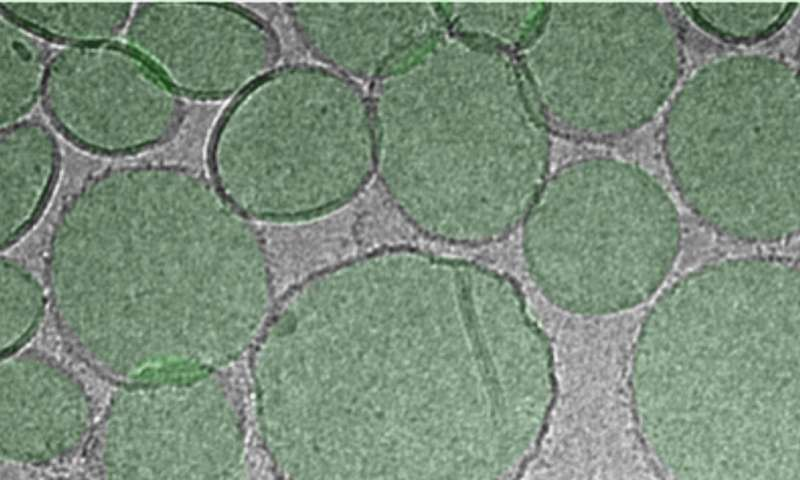Oct 29 2020
Researchers led by the University at Buffalo (UB) have devised a new method that could enhance the effectiveness of vaccines against the novel coronavirus, the virus that is responsible for causing COVID-19.
 A close-up view of the RBD particle vaccine (green). Image Credit: Facility for Electron Microscopy Research (FEMR) at McGill University.
A close-up view of the RBD particle vaccine (green). Image Credit: Facility for Electron Microscopy Research (FEMR) at McGill University.
Jonathan F. Lovell, PhD, an associate professor in the Department of Biomedical Engineering at UB, is the principal investigator of the study titled “SARS-CoV-2 RBD Neutralizing Antibody Induction is Enhanced by Particulate Vaccination,” published online in the Advanced Materials journal on October 28th, 2020.
COVID-19 has resulted in an uncontrollable global pandemic, which has infected a minimum of 40 million people around the world and resulted in over 220,000 deaths in the United States alone. As the disease started spreading in early 2020, biomedical researchers have been working actively to develop an effective vaccine.
Lovell thinks that one solution could be to develop vaccines that partly imitate the virus structure. One of the proteins on the virus—situated on the characteristic COVID spike—includes a component known as the receptor-binding domain, or RBD, which is its “Achilles heel.” Lovell stated that antibodies against this part of the virus have the ability to neutralize the virus.
It would be appealing if a vaccine could induce high-levels of antibodies against the RBD. One way to achieve this goal is to use the RBD protein itself as an antigen, that is, the component of the vaccine that the immune response will be directed against.
Jonathan F. Lovell, Associate Professor, Department of Biomedical Engineering, University at Buffalo
The researchers speculated that if the RBD is transformed into a nanoparticle (similar in size to the virus itself) rather than retaining it in its natural form as a tiny protein, it would produce higher levels of neutralizing antibodies and its potential to produce an immune response would increase.
Earlier, Lovell’s group had designed a technology that enables the simple transformation of small, purified proteins into particles by using liposomes, or small nanoparticles developed from naturally occurring fatty components.
In the latest study, the team added a unique lipid known as cobalt-porphyrin-phospholipid or CoPoP inside the liposomes. The lipid allows the RBD protein to quickly bind to the liposomes, developing more nanoparticles that produce an immune response, stated Lovell.
The researchers noticed that when the RBD was transformed into nanoparticles, it retained its correct, three-dimensional shape and the particles were stable in incubation conditions, analogous to those present in the human body.
High antibody levels were induced in laboratory rabbits and mice immunized with the RBD particles. When compared to other materials integrated with the RBD to improve the immune response, only the method with particles containing CoPoP ensured a powerful response.
According to Lovell, other vaccine adjuvant technologies cannot transform the RBD into particle-form.
We think these results provide evidence to the vaccine-development community that the RBD antigen benefits a lot from being in particle format. This could help inform future vaccine design that targets this specific antigen.
Jonathan F. Lovell, Associate Professor, Department of Biomedical Engineering, University at Buffalo
This research was funded by the U.S. National Institutes of Health, and the Facility for Electron Microscopy Research (FEMR) at McGill University. FEMR is supported by the Canadian Foundation for Innovation, Quebec Government, and McGill University.
Journal Reference:
Huang, W.-C., et al. (2020) SARS-CoV-2 RBD Neutralizing Antibody Induction is Enhanced by Particulate Vaccination. Advanced Materials. doi.org/10.1002/adma.202005637.